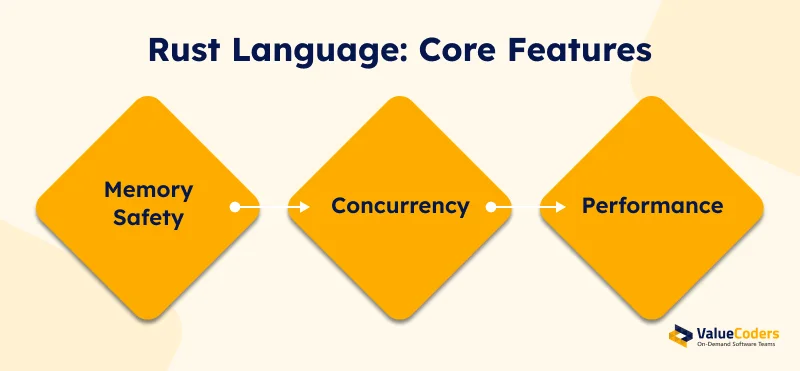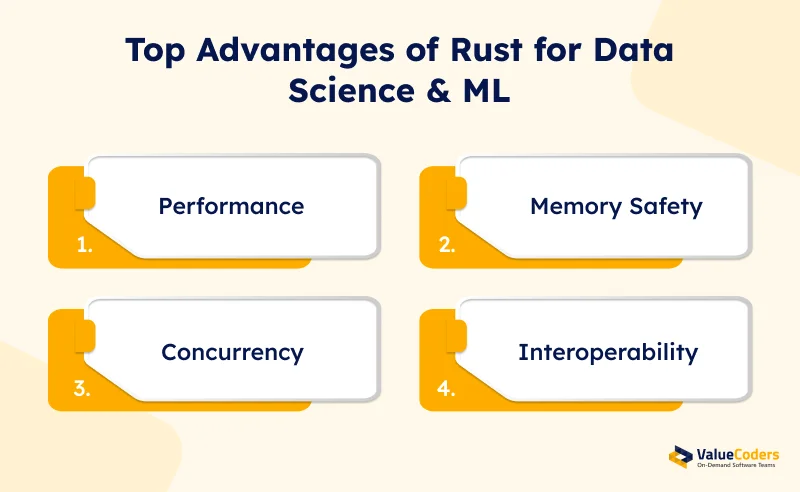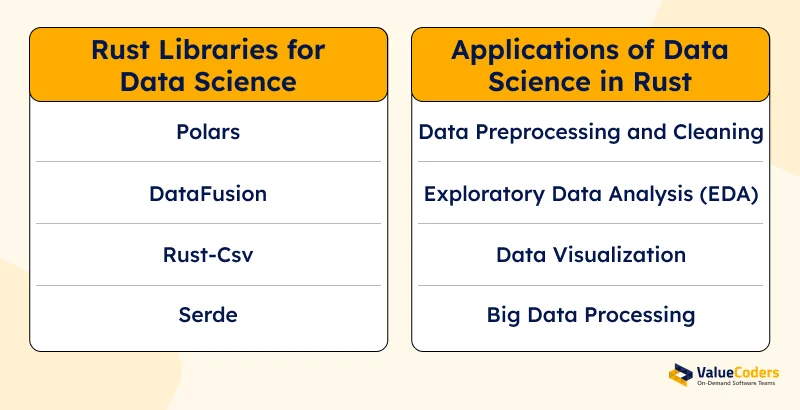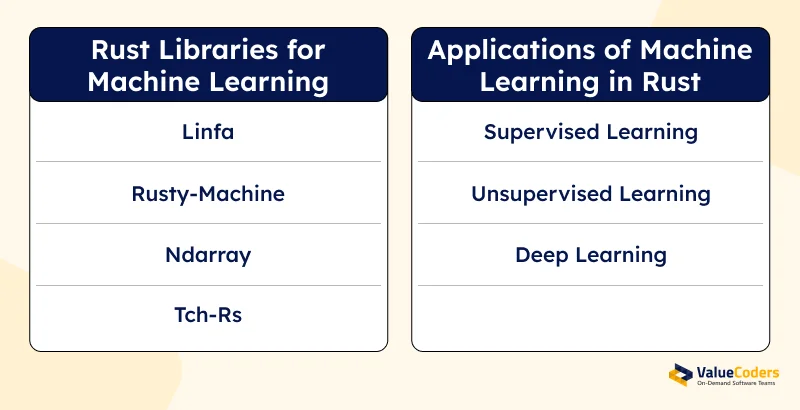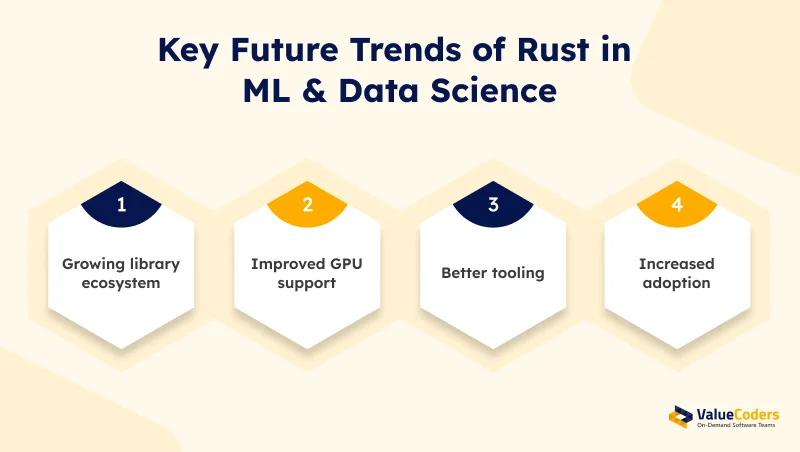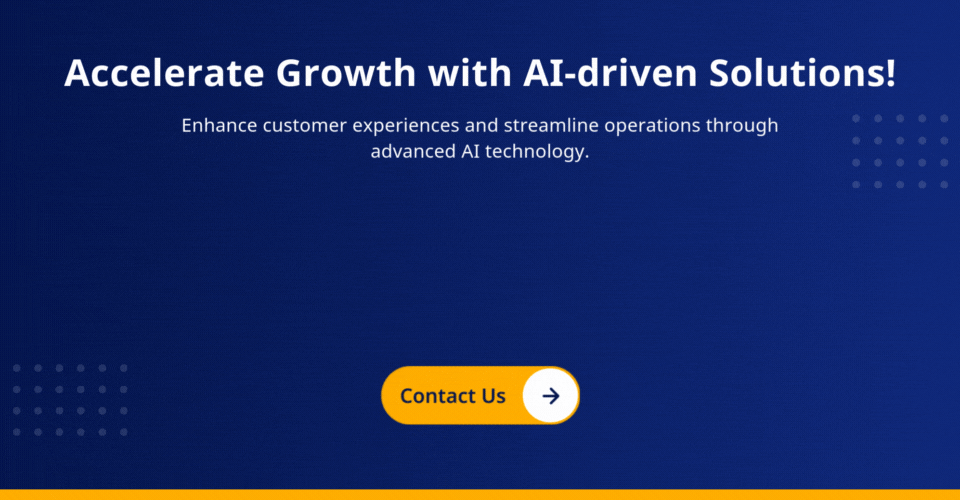The global Machine Learning market is going to reach USD 225.91 billion by 2030 with a CAGR of 36.2%, while the global market for data science technology will reach approx. USD 1826.9 billion by the year 2033.
This growing demand for both technologies has pushed businesses to opt for programming languages that ensure reliability, speed, and safety.
Various old languages are unable to meet the demands of modern data-centric applications; thus, Rust has emerged as a powerful option for addressing such challenges.
Businesses managing large-scale data projects deal with a vast amount of information. Inefficiencies, memory errors, and complex computations can affect project progress.
However, Rust can handle all such issues and has become a reliable choice for companies aiming to invest highly in ML and data science.
Here, you will explore what a RUST language is exactly and how it is gaining momentum in ML and data science.
An Introduction to Rust Language
Developed by software developer Graydon Hoare, RUST is a systems programming language that mainly focuses on performance, concurrency, and safety. It provides cross-platform support and also predicts runtime behavior.
In the ML and data science landscape, it is a strong contender and an ideal choice for organizations that want to enhance their data-driven decision-making processes.
Key Characteristics of Rust
Rust is a systems programming language built with safety, speed, and reliability. It avoids common bugs and helps write clean code under pressure.
- Memory Safety: The Rust language ensures that memory is allocated and deallocated without crashes or leaks, further reducing runtime errors.
- Concurrency: Rust enables software developers to write concurrent code safely. This helps in avoiding race conditions and other concurrency pitfalls.
- Performance: Rust offers low-level control with minimal overhead, making it as fast as C or C++. This further ensures that large datasets and computations can be handled efficiently.
Eliminate performance bottlenecks in your ML workflows with Rust, delivered by our 450+ AI specialists.
Advantages of Rust for Data Science and Machine Learning
Rust offers strong memory safety and fast execution, which can be useful when working with large datasets or complex computations. It lets developers build high-performance tools without sacrificing code clarity.
Let’s look at the key advantages of Rust for ML and Data Science:
1. Performance
Its direct memory control allows software programmers to fine-tune their code for maximum speed. It uses less memory, runs at bare metal speed, and avoids runtime issues.
- Low-Level Control: Rust provides fine-grained control over system resources, which allows companies to maximize the utilization of resources.
- Optimized Memory Management: By doing away with the garbage collection overhead, Rust maintains smooth operation during big operations.
- Zero-Cost Abstractions: Programmers can use readable, high-level code without losing execution speed.
2. Memory Safety
RUST compiler identifies frequent bugs like buffer overflows, null pointer crashes, data races, and early memory leaks.
- Automatic Memory Management: Rust avoids problems like dangling pointers and double frees, making software stable.
- Increased Stability: Programs developed using Rust are less likely to crash because of memory-related faults.
- Improved Security: Rust’s compile-time safety features counteract risks inherent to other languages.
- Easier Debugging: Clear error messages and strict rules make troubleshooting more straightforward.
3. Concurrency
RUST ensures safety for parallel processing by using lock-free data structures, thread isolation, message passing, and simple scaling across CPU scores.
- Enhanced Performance: Rust’s concurrency system manages multiple processes effectively, providing increased throughput.
- Improved Resource Utilization: Rust facilitates the safe sharing of data between threads, which is important for parallel computation.
- Enhanced User Experience: Applications built with Rust respond faster to user queries due to streamlined processing.
4. Interoperability
RUST integrates nicely with other languages, such as Python bindings, WebAssembly, FFI(Foreign Function Interface,) and C ABI compatibility.
- Improved Flexibility: Rust integrates nicely with languages such as Python and R, allowing businesses to use existing tools in combination with Rust.
- Improved Collaboration: Rust can be implemented with other programming languages while staying compatible.
- Future-Proofing: Rust’s flexibility guarantees long-term viability with changing technologies
Also Read – The Role of Machine Learning in Predictive Analytics and Decision-making
What is the Role of Rust in Data Science?
Data science increasingly utilizes Rust language for projects calling for strong performance and reliability, given that Python and R. have traditionally dominated the domain. It provides a competitive advantage to industries that depend on precise and timely data insights.
Effective Data Processing
Rust’s fast data processing is optimal for big data pipelines. Frameworks like Polars and DataFusion make it easier to manipulate and query data, making Rust a great fit for resource-hungry startups.
Error-Free Code Execution
Rust eliminates common memory-related issues like segmentation faults and null pointer dereferences. This reliability ensures that data science models and algorithms run seamlessly, reducing downtime in critical operations.
Integration with Existing Ecosystems
Rust can be combined with Python, R, or other technologies so that startups can take advantage of Rust’s speed without giving up familiar libraries. For example, Expert Python developers can employ Rust for backend tasks to enable smooth operations in data-driven applications.
Scalable Solutions
Rust’s concurrency features enable safe and efficient parallel processing, a critical requirement for businesses handling real-time analytics or processing extensive datasets. Startups working with IoT, fintech, or predictive analytics often find Rust advantageous in building scalable, data-intensive solutions.
List of Rust Libraries for Data Science
Rust’s ecosystem includes a growing number of tools made for data tasks. From basic data handling to statistical operations, several libraries support data workflows in Rust. Have a look at the rust data science libraries below:
1. Polars
- A fast DataFrame library optimized for handling large datasets.
- Offers lazy evaluation for efficient query execution.
- Provides a familiar interface for those experienced with Python’s pandas.
2. DataFusion
- Enables SQL-based data queries on large datasets.
- Supports parallel processing, allowing faster data analysis.
- Integrated with Apache Arrow for efficient in-memory processing.
3. Rust-Csv
- A lightweight library for reading and writing CSV files.
- Handles large CSV datasets efficiently with support for streaming.
4. Serde
- Facilitates data serialization and deserialization across formats like JSON and YAML.
- Customizable to fit specific business needs.
List of Data Science Applications in Rust
Rust is slowly entering data-focused projects, especially where speed and stability are critical. Expert data scientists use this in real-time analytics, data processing, and backend engines for dashboards.
1. Data Preprocessing and Cleaning
RUST handles missing data through strategies like imputation or removal. It also detects and manages outliers for accurate analyses.
- Fast text processing
- Missing value handling
- Type conversion
- Outlier detection
2. Exploratory Data Analysis (EDA)
RUST uses visual tools like histograms and scatter plots to understand data distributions. It helps calculate key metrics such as mean, median, and variance for summary statistics.
- Summary statistics
- Distribution analysis
- Pattern detection
- Correlation studies
3. Data Visualization
RUST has libraries like Plotters and Vega-Lite to help create interactive charts and graphs. It uses heat maps and box plots to identify trends and patterns.
- Plot generation
- Interactive charts
- Real-time updates
- Custom visualizations
4. Big Data Processing
Rust’s efficiency supports real-time processing of high-volume data streams. It has libraries like Polars and DataFusion, which makes Rust ideal for enterprise-scale analytics.
- Parallel processing
- Streaming computations
- Memory-efficient algorithms
- Disk-based processing
We craft Rust-powered AI systems that reduce processing time by up to 60%. Let’s connect with our AI experts today.
What is the Role of Rust in Machine Learning?
Although not as deeply rooted as Python in machine learning development, its increasing library ecosystem and intrinsic language characteristics make Rust a plausible option for performance-critical machine learning applications.
Faster Model Training
Rust’s performance enables startups to train machine learning models faster, shortening the time to market for their products. Libraries such as Linfa and Tch-Rs (PyTorch bindings) offer tools to construct and train ML models effectively.
Reliability in Production
For startups with production-deployed ML models, Rust’s safety features for memory ensure apps continue running stably even when highly loaded. Such is particularly critical in healthcare and autonomous systems markets where precision and reliability cannot be compromised.
Customizable Solutions
Low-level control through Rust allows engineers to adjust and optimize algorithms tailored to their function. This capability is perfectly suitable for startups who venture into bespoke ML solutions or create specialized offerings.
Parallel Computing
Rust’s concurrency features simplify training large-scale models on multiple cores or GPUs. Deep learning or real-time AI systems can greatly benefit from this functionality in startups.
List of Rust Libraries for Machine Learning
While not as extensive as Python’s, Rust’s collection of machine learning libraries continues to expand. These tools offer neural networks, decision trees, and other algorithms that run with impressive speed.
Let’s look at the top rust libraries for machine learning solutions:
1. Linfa
A modular library supporting algorithms like linear regression and k-means clustering.
Simplifies the development of both supervised and unsupervised models.
2. Rusty-Machine
Focused on ease of use, offering implementations of decision trees and neural networks.
Well-suited for developers new to ML into business operations.
3. Ndarray
A numerical computing library enabling efficient manipulation of n-dimensional arrays.
Comparable to NumPy in functionality.
4. Tch-Rs
Rust bindings for PyTorch, providing a seamless interface for deep learning tasks.
Supports pre-trained models and GPU acceleration.
List of Rust Machine Learning Applications
Some developers have started using Rust to build ML tools where speed, thread safety, and low memory use are essential. It’s especially helpful in embedded systems, game engines, and edge computing.
1. Supervised Learning
Classification: Build models to categorize data into predefined classes (e.g., spam detection).
- Binary classification
- Multi-class problems
- Text classification
- Image recognition
Regression: Predict continuous values like sales figures or stock prices.
- Linear regression
- Polynomial fitting
- Time series prediction
- Feature selection
2. Unsupervised Learning
Clustering: Group similar data points for market segmentation or anomaly detection.
- K-means
- DBSCAN
- Hierarchical clustering
- Density estimation
Dimensionality Reduction: Techniques like PCA simplify high-dimensional datasets for easier analysis.
- Principal Component Analysis
- t-SNE
- UMAP
- Feature extraction
3. Deep Learning
Neural Networks: Develop models for tasks like image recognition and natural language processing.
- Feed-forward networks
- Convolutional networks
- Recurrent networks
- Auto-encoders
Transfer Learning: Adapt pre-trained models for new tasks, reducing training time.
- Pre-trained model usage
- Fine-tuning
- Feature extraction
- Model adaptation
Also Read – Does Your Business Need a Data Engineer or Data Scientist?
Integrating Rust with Other ML/DS Ecosystems
Rust can be connected with tools from other ecosystems like Python or R through bindings and APIs. This allows teams to enjoy Rust’s speed while still using familiar platforms.
Python Integration
Libraries like PyO3 allow Rust to complement Python applications.
Rust modules can handle computationally intensive tasks within Python workflows.
- PyO3 bindings
- Numpy interop
- Pandas conversion
- Scikit-learn compatibility
R Integration
Rust bridges gaps with R through tools like Feather for efficient data exchange.
Enables statistical analysis combined with Rust’s computational strengths.
- Extendr framework
- Data.frame conversion
- Statistical computing
- Graphics generation
Rust as a Backend
Ideal for developing performance-critical components in larger ML/DS pipelines.
Enhances system reliability and reduces runtime errors.
- Web service deployment
- Model serving
- API development
- Real-time processing
Pro Tip: You may hire machine learning experts from ValueCoders to integrate Rust hassle-free into your business operations.
We have already helped 2500+ clients cut model latency. Our Rust engineers are ready to do the same for you.
Challenges and Limitations of Rust in ML/DS
While Rust offers many advantages, it also presents challenges. The learning curve can be steep for developers unfamiliar with its concepts. Additionally, the ecosystem is still growing, which may limit available libraries compared to more established languages.
- Steeper Learning Curve: Developers transitioning from Python or R may find Rust’s syntax more complex.
- Limited Libraries: The ecosystem for ML/DS in Rust is still growing, requiring workarounds for certain tasks.
- Community Support: While expanding, Rust’s community resources for data science lag behind those of Python or R.
Also Read – Best Practices for Integrating Machine Learning Models into Software Applications
Future of Rust in Machine Learning and Data Science
The future of Rust in ML and data science looks promising. As more developers recognize its benefits, the ecosystem will continue to expand. Rust’s focus on safety and performance aligns well with the increasing demands of data-intensive applications.
Growing Library Ecosystem
Rust’s library ecosystem is progressively growing, and there has been an influx of new libraries designed for machine learning and data science. With this expansion, it is becoming easier for developers to create strong, high-performance applications.
Enhanced GPU Support
As GPU support becomes more integrated in Rust, it provides access to more rapid computations and more extensive model training features, especially in performance-constrained environments.
Better Tooling
The Rust developer experience is being accelerated with improved debugging, data management, and visualization tools. All this is lessening friction and making data workflows more seamless for professionals.
Wider Adoption
More organizations and teams are adopting Rust for data-oriented projects based on its performance, security, and increasing support from the community. This growth points to an encouraging future in research and production.
Conclusion
Rust offers significant benefits for businesses venturing into ML and data science. Its focus on safety, concurrency, and computational efficiency positions it as a strong contender in these fields.
By adopting Rust, organizations can build reliable systems that meet the demands of modern data challenges. For businesses already invested in data projects, exploring Rust could open doors to improved operations and stronger applications.


